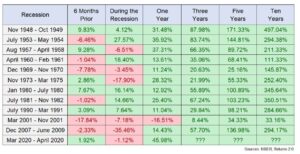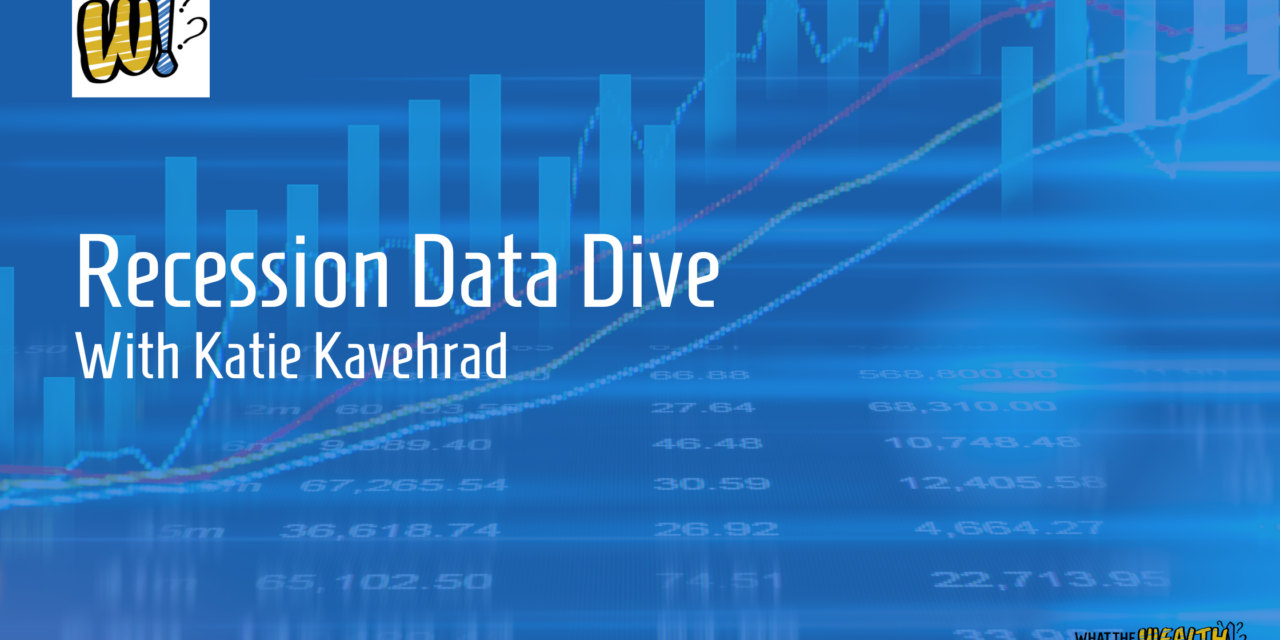In today’s episode, we have some good news to share, we talk through recession data, and reasons to be optimistic about the short and long-term future.
Welcome, Katie!
Today we have a special guest! Katie Kavehrad joined Paradigm Wealth in March of this year as a financial planner. Katie helps clients build plans that will provide them with financial confidence and act as a road map to achieving their long-term dreams.
Katie and her family moved from the Pacific Northwest, the land of hiking, waterfalls, and Powell’s City of Books, the largest independent bookstore in the world.
A Bit of Good News
Katie keeps up with changes that will impact her clients’ lives from a financial planning perspective, and recently there have been some positive changes announced for retirees and soon-to-be retirees.
The Centers for Medicare & Medicaid Services (CMS) announced that for 2023, Medicare Part B premiums will decrease to $164.90, which is a decrease of $5.20 from 2022’s cost of $170.10. And the annual Part B deductible will decrease to $226, a reduction of $7 from $233.
And there is more good news! The cost of living adjustment (COLA) for Social Security benefits in 2023 is 8.7%. This is a big jump; last year’s COLA was 5.9%, and since COLA was introduced in 1975, it’s only risen above 7% five times. The 2023 COLA is the biggest increase since 1981. This is what the increase will look like:
- Retirees: Average monthly increase of $146, average 2023 check, $1,827
- Worker with disabilities: Average monthly increase of $119, average 2023 check, $1,483
- Senior couple each receiving benefits: Average monthly increase of $238, average 2023 check, $2,972
- Widow/Widower: Average monthly increase of $137, average 2023 check, $1,704
- Widow/Widower with two children: Average monthly increase of $282, average 2023 check, $3,520
COLA is based on inflation; for years, inflation has been so low that the increases haven’t really had a lot of impact. With inflation currently the highest it’s been in decades, next year’s increase and changes to Medicare Part B will be impactful for beneficiaries.
Recession Data
Even casual news watchers know that there has been a steady stream of gloom and doom regarding the market and economy over the last six months or so. There is some debate as to whether or not we’re in a recession. The general definition of a recession is two consecutive quarters of negative gross domestic product (GDP). By that definition, the U.S. entered a recession this past summer. Most economists don’t believe we’re in a recession, though, but agree that one is almost certainly coming.
What does that mean for the market? We can look back to see how the market has performed in and around recessions. This chart from A Wealth of Common Sense does a great job of breaking things down.

The chart shows returns from the S&P 500 around times of recession, six months prior to a recession, during a recession, and one, three, five, and ten years post-recession.
There is a lot going on, inflation, the Fed raising interest rates, the war in Ukraine, the mid-term elections. We’ve been talking about these things and how they’re impacting the market on the podcast for much of this year. Mid-term elections create a lot of noise on the front end where the market is concerned, but the market usually rallies a bit once the election is over. It’s less of a matter of who wins or loses and more a matter of ending uncertainty, as the market does not like uncertainty.
But the main driver of what is happening now is inflation and the Fed increasing interest rates as a way to try and quell it. The Fed is trying to avoid what happened in the 1970s. CDs may have been earning 15%, but inflation was at 13%, so there was no real growth.
Paul Volcker was the Chair of the Federal Reserve from 1979 to 1987. He raised interest rates high and fast in an effort to knock down inflation and kicked off a roughly 40-year bull market.
Of course, there were bumps in the road over that time period, Black Monday in 1987, when the market lost 25% of its value in a single day, the dotcom bust, the 2007-2008 financial crisis, and the pandemic among them. There were significant declines multiple times, but the market has been up a lot over those years, even when you factor in the downturns.
The market has historically been a leading indicator of the direction of the economy, it seems to know in advance what is going to happen.
In the 12 periods indicated in the chart, in the six months leading up to a recession, six were positive, and six were negative. During the recessions, six were positive, and six were negative, the worst being during the financial crisis when the market was down more than 35% and much of the world thought the entire banking system was about to collapse. It took multiple rounds of quantitative easing, which is financial jargon for becoming very loose on monetary policy, to spur economic growth and turn things around, but they did turn around.
One year out from a recession, there are 11 positive and 1 negative period. Three, five, and ten years out, all 12 periods were positive. There is a lot of anxiety around the word recession, but we see it as an opportunity for the focused, long-term investor. Be consistent, stay disciplined, stay the course, and you’ll get good returns. Of course, there are no guarantees when it comes to investing, but we have so much historical data to look back on that shows positive outcomes that it’s easy to be optimistic.
Most recessions and bear markets last between 12 and 18 months; we’re currently about nine months into things, so my guess is that we’re at least halfway done. I certainly don’t expect things to fall another 25%.
The likelihood of a recession has already been built into the price of asset classes. Markets tend to be forward-looking and start to recover even while the economy continues to struggle.
Investing now in good quality companies will almost certainly pay off for long-term equity investors. Companies that drive innovation, that make products we use everyday. Returns over those ten-year periods were 100% to 400% higher; this is huge for a long-term outlook. Now is an excellent opportunity to invest in your future. More and more of us are living into our 90s; if we don’t take advantage of opportunities when presented, we risk running out of money.
Companies are taking their extra cash and buying back stock. Share buybacks topped $1 trillion in June of this year. For shareholders, this makes shares more valuable. It reduces the number of outstanding shares available to buy and makes earnings on future shares look better, driving share prices in the long-term. Turn on dividend reinvesting. It allows you to buy more shares at a lower price, increasing your dividends in the future when prices rebound.
So don’t believe everything is doom and gloom. There are a lot of reasons to be optimistic if you’re a long-term investor.
If you have any questions, reach out to me. You can find Katie here.
And check out my new YouTube channels. The videos are short, walk and talks, where I take a stroll and talk about whatever’s on my mind. And I have a Paradigm Wealth Partners channel too.
The economic forecasts set forth in this material may not develop as predicted and there can be no guarantee that strategies promoted will be successful.
Advisors associated with Paradigm Wealth Partners may be either (1) registered representatives with, and securities offered through LPL Financial, Member FINRA/SIPC, and investment advisor representatives of Paradigm Wealth Partners; or (2) solely investment advisor representatives of Paradigm Wealth Partners, and not affiliated with LPL Financial. Investment advice offered through Paradigm Wealth Partners, a registered investment advisor. Paradigm Wealth Partners is a separate entity from LPL Financial.
Katie Kavehrad is solely an investment advisor representative of Paradigm Wealth Partners, and not affiliated with LPL Financial.
Listen to the Full Episode:
What You’ll Learn In Today’s Episode:
- Some good news and updates from the markets.
- The importance of using data to gain a better understanding of opportunities.
- Key indicators to pay attention to.
- How to understand what to do (or what not to do) during a recession.
Ideas Worth Sharing:
“If you’re already receiving Social Security, it looks like you’ll get a nice increase in COLA for the next year.” – Katie Kavehrad
“If we look at the 3-year, 5-year, and 10-year post-recessionary returns, you can see that performance there and what it really represents is this opportunity to be consistent, disciplined, and stay the course. There’s going to be some positive returns.” – Katie Kavehrad
“The market is a leading indicator, and it knows somewhat in advance what’s going to happen.” – Jonathan Bednar
Resources In Today’s Episode:
- Katie Kavehrad: Email | LinkedIn
- Jonathan Bednar: Email | Twitter | LinkedIn
- A Wealth of Common Sense
- What The Wealth?! by Jonathan Bednar
Enjoy the show? Use the Links Below to Subscribe:





